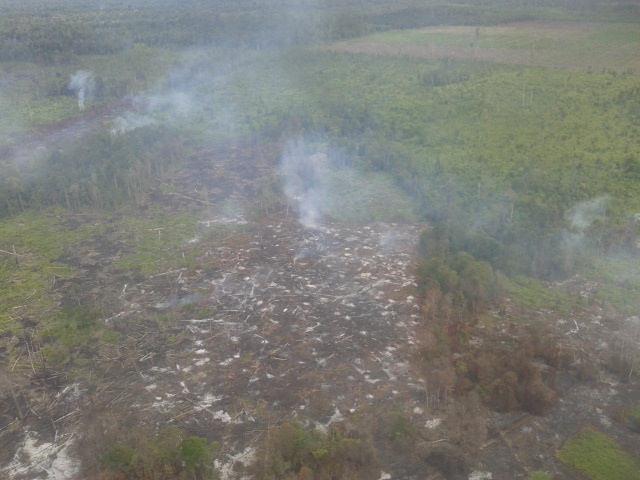
Forest fires in Indonesia are a big problem, and so is deforestation. A fire is now burning on the Indonesian island of Sumatra, where a state of emergency has been declared, the BBC reported. Mapping both forest fires and deforestation is important, and Greenpeace Indonesia just launched a mapping tool that will do both. The tool will also show who controls the land where forest fires and deforestation are occurring.
The interactive map is called Kepo Hutan, and with it users will be able to see if a fire is on peatland or primary or secondary forests. They will also be able to tell if the fire is in tiger or orangutan habitat, or on land with palm oil or pulpwood cultivation, logging or coal mining. The map was created using open-source technology from Global Forest Watch.
“Indonesia is still recovering from last year’s fires disaster, driven in large part by reckless peatland draining and forest clearing for plantations. In the wake of the fires, President Joko Widodo announced new plans to protect and restore damaged and at-risk areas,” said Greenpeace Indonesia forest campaigner Teguh Surya in a statement.The 2015 forest fires in Indonesia were the worst in over a decade, according to Greenpeace. They cost the country an estimated $16 billion, plus haze from the fires impacted millions of people in Indonesia and neighboring Malaysia and Singapore.
Rainforests and peatlands are both very important Indonesian ecosystems. Rainforest areas equal to 300 soccer fields are being destroyed every hour, Rainforest Rescue states on its website. Tropical deforestation accounts for about 18 percent of greenhouse gas emissions. Indonesia has the world’s third largest area of tropical rainforest, and 68 percent of the country’s landmass is covered by forests. Rainforests are being destroyed to make way for plantations.
The largest tropical peatland in the world is in Indonesia and it acts as a carbon sink. Indonesia is a the third largest emitter of greenhouse gases in the world, and carbon emissions caused by peat decomposition and peat fires are 42 percent of the country’s total emissions. Greenpeace refers to peatlands as “perhaps the world's most critical carbon stores,” and they store about 35 billion tons of carbon. And that carbon is released when they are drained, burned and replaced with plantations.
One of the biggest culprits of deforestation and destruction of peatlands in Indonesia are oil palm plantations. Indonesia and Malaysia combined supply 90 percent of the global market for palm oil. When peatlands and rainforests are destroyed to make way for oil palm plantations, endangered species are killed, local communities are uprooted and more carbon is released into the atmosphere. Indonesia’s peatlands and rainforests are home to endangered species such as orangutans, Sumatran tigers and Bornean rhinos. Orangutans are dependent on large forest areas and when they search for food after rainforests are destroyed, they can end up on plantations where they are considered pests. There is a risk that wild orangutans will not live outside of protected areas by 2020.
With a heavy global demand for palm oil, the destruction continues. About 50 percent of the goods we use daily contain palm oil -- with everything from processed foods to personal care products containing it. Palm oil is the “most widely produced vegetable oil worldwide,” according to Rainforest Rescue. Indonesia’s oil palm plantations cover 9 million hectares, an area about the size of Maine, and it is projected that they will cover 26 million hectares by 2025.
Some companies are starting to make commitments to source sustainably-produced palm oil. Johnson & Johnson is one of them. The personal care product company introduced its Responsible Palm Oil Sourcing Criteria in 2014. The sourcing criteria includes no developing of high carbon stock forests, no developing of peatlands, and no use of burning to clear land of new developments or to replant. Since the launch of its sourcing criteria, the company has engaged all of its leading suppliers, which represent almost 85 percent of its palm oil derivatives supply. The goal is to completely implement its sourcing criteria by the end of 2020.
If the majority of companies had similar commitments, deforestation in Indonesia could be a thing of the past.
Image credit: Flickr/Chris Daley

Gina-Marie is a freelance writer and journalist armed with a degree in journalism, and a passion for social justice, including the environment and sustainability. She writes for various websites, and has made the 75+ Environmentalists to Follow list by Mashable.com.














